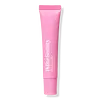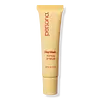What's inside
What's inside
 Key Ingredients
Key Ingredients

 Benefits
Benefits

 Concerns
Concerns

 Ingredients Side-by-side
Ingredients Side-by-side

Hydrogenated Polyisobutene
EmollientHelianthus Annuus Seed Oil
EmollientPolybutene
Ethylene/Propylene/Styrene Copolymer
Corylus Avellana Seed Oil
EmollientCaprylic/Capric Triglyceride
MaskingButylene/Ethylene/Styrene Copolymer
Bis-Diglyceryl Polyacyladipate-2
EmollientPentaerythrityl Tetraisostearate
EmollientPhenoxyethanol
PreservativeDiethylhexyl Syringylidenemalonate
Skin ProtectingAroma
Simmondsia Chinensis Seed Oil
EmollientSodium Saccharin
MaskingLimonene
PerfumingEthylhexylglycerin
Skin ConditioningPentaerythrityl Tetra-Di-T-Butyl Hydroxyhydrocinnamate
AntioxidantTocopheryl Acetate
AntioxidantGlycine Soja Oil
EmollientLinalool
PerfumingCitrus Aurantifolia Oil
CleansingCitral
PerfumingSambucus Nigra Flower Extract
RefreshingCitrus Aurantium Amara Flower Extract
RefreshingJasminum Officinale Flower Extract
MaskingPrunus Serrulata Flower Extract
Skin ConditioningLavandula Angustifolia Flower Extract
CleansingPaeonia Officinalis Flower Extract
TonicTocopherol
AntioxidantRosa Damascena Flower Oil
MaskingTitanium Dioxide
Cosmetic ColorantCI 73360
Cosmetic ColorantCI 15850
Cosmetic ColorantIron Oxides
Hydrogenated Polyisobutene, Helianthus Annuus Seed Oil, Polybutene, Ethylene/Propylene/Styrene Copolymer, Corylus Avellana Seed Oil, Caprylic/Capric Triglyceride, Butylene/Ethylene/Styrene Copolymer, Bis-Diglyceryl Polyacyladipate-2, Pentaerythrityl Tetraisostearate, Phenoxyethanol, Diethylhexyl Syringylidenemalonate, Aroma, Simmondsia Chinensis Seed Oil, Sodium Saccharin, Limonene, Ethylhexylglycerin, Pentaerythrityl Tetra-Di-T-Butyl Hydroxyhydrocinnamate, Tocopheryl Acetate, Glycine Soja Oil, Linalool, Citrus Aurantifolia Oil, Citral, Sambucus Nigra Flower Extract, Citrus Aurantium Amara Flower Extract, Jasminum Officinale Flower Extract, Prunus Serrulata Flower Extract, Lavandula Angustifolia Flower Extract, Paeonia Officinalis Flower Extract, Tocopherol, Rosa Damascena Flower Oil, Titanium Dioxide, CI 73360, CI 15850, Iron Oxides
Triisostearin
Skin ConditioningHydrogenated Polyisobutene
EmollientPolyglyceryl-2 Triisostearate
EmulsifyingEthylhexyl Palmitate
EmollientDextrin Palmitate
EmulsifyingSqualane
EmollientDextrin Palmitate/Ethylhexanoate
EmulsifyingSorbitan Isostearate
EmulsifyingDiisostearyl Malate
EmollientSimmondsia Chinensis Butter
Skin ConditioningHelianthus Annuus Seed Oil
EmollientEthylhexylglycerin
Skin ConditioningPunica Granatum Flower Extract
Skin ConditioningPolyglyceryl-3 Diisostearate
EmulsifyingTribehenin
EmollientCarthamus Tinctorius Seed Oil
MaskingRicinus Communis Seed Oil
MaskingSimmondsia Chinensis Leaf Extract
HumectantSimmondsia Chinensis Seed Oil
EmollientTocopheryl Acetate
AntioxidantSodium Hyaluronate
HumectantAroma
Hydrogenated Castor Oil
EmollientLactic Acid
BufferingPrunus Persica Fruit Extract
AbrasiveVaccinium Angustifolium Fruit Extract
Skin ProtectingPalmitoyl Tripeptide-1
Skin ConditioningTriisostearin, Hydrogenated Polyisobutene, Polyglyceryl-2 Triisostearate, Ethylhexyl Palmitate, Dextrin Palmitate, Squalane, Dextrin Palmitate/Ethylhexanoate, Sorbitan Isostearate, Diisostearyl Malate, Simmondsia Chinensis Butter, Helianthus Annuus Seed Oil, Ethylhexylglycerin, Punica Granatum Flower Extract, Polyglyceryl-3 Diisostearate, Tribehenin, Carthamus Tinctorius Seed Oil, Ricinus Communis Seed Oil, Simmondsia Chinensis Leaf Extract, Simmondsia Chinensis Seed Oil, Tocopheryl Acetate, Sodium Hyaluronate, Aroma, Hydrogenated Castor Oil, Lactic Acid, Prunus Persica Fruit Extract, Vaccinium Angustifolium Fruit Extract, Palmitoyl Tripeptide-1
Ingredients Explained
These ingredients are found in both products.
Ingredients higher up in an ingredient list are typically present in a larger amount.
Aroma refers to an ingredient, or mixture of ingredients, that impart or mask a flavor.
The name is slightly confusing. This is because INCI associates aroma with flavor instead of smell.
Here is the official definition from the The International Cosmetic Ingredient Dictionary and Handbook:
“Aroma is a term for ingredient labeling used to identify that a product contains a material or combination of materials normally added to a cosmetic to produce or to mask a particular flavor.”
INCI shows the only purpose of aroma to be "flavouring".
However, due to regulation differences, some companies may use aroma in place of parfum.
In Canada, this ingredient only has to be listed in concentrations above 1%.
Learn more about AromaEthylhexylglycerin (we can't pronounce this either) is commonly used as a preservative and skin softener. It is derived from glyceryl.
You might see Ethylhexylglycerin often paired with other preservatives such as phenoxyethanol. Ethylhexylglycerin has been found to increase the effectiveness of these other preservatives.
Helianthus Annuus Seed Oil is the oil derived from the seeds of a Sunflower. Sunflower seed oil is non-fragrant. It is an emollient, meaning it helps to soften the skin.
Sunflower seed oil contains many fatty acids. The fatty acids found in sunflower seeds include (from highest amount to least): linoleic acid, myristic acid, palmitic acid, stearic acid, arachidic acid, oleic acid, and linolenic acid.
These fatty acids help the skin create ceramides. Ceramides play a role in repairing the skin barrier.
Helianthus Annuus Seed Oil helps moisturize the skin. This in turn helps the skin look more rejuvenated and smoother.
Sunflowers are rich in vitamin E.
Historians believe Indigenous cultures of North America domesticated sunflowers before corn. Thus they relied on sunflower oil for a variety of uses. One such use is moisturizing skin and hair.
Sunflower seed oil may not be fungal acne safe. We recommend speaking with a professional if you have any concerns.
Learn more about Helianthus Annuus Seed OilHydrogenated Polyisobutene is a synthetic polymer. Polymers are compounds with high molecular weight. Hydrogenated Polyisobutene is an emollient and texture enhancer.
In one study, Hydrogenated Polyisobutene showed better skin hydration levels than Caprylic/Capric Triglyceride. As an emollient, it helps keep your skin soft and hydrated by trapping moisture in.
Hydrogenated Polyisobutene is often used as a mineral oil replacement.
Learn more about Hydrogenated PolyisobuteneThis oil comes from the seeds of the desert shrub called Jojoba. It is more commonly known as jojoba oil, a non-comedogenic oil.
Jojoba oil does not contain fragrance and has many fatty-acids, making it a great soothing ingredient.
It also contains Vitamin E, a great moisturizing ingredient. Vitamin E is also an antioxidant and protects your skin against oxidative damage.
This ingredient humectant properties, meaning it helps draw moisture from the air. This helps keep your skin hydrated.
While jojoba has antibacterial properties, it is only able to kill some strains of bacteria.
Studies also show it helps in wound healing. In fact, Indigenous cultures have used jojoba as a moisturizer and to help treat burns for centuries.
Fun fact: Jojoba oil similar to natural human skin sebum, so it has a great effect on dry skin. It is also promising with helping to regulate sebum production.
Due to its fatty acid content, Jojoba oil may not be fungal acne safe. We recommend speaking with a professional if you have any concerns.
Learn more about Simmondsia Chinensis Seed OilTocopheryl Acetate is AKA Vitamin E. It is an antioxidant and protects your skin from free radicals. Free radicals damage the skin by breaking down collagen.
One study found using Tocopheryl Acetate with Vitamin C decreased the number of sunburned cells.
Tocopheryl Acetate is commonly found in both skincare and dietary supplements.
Learn more about Tocopheryl Acetate